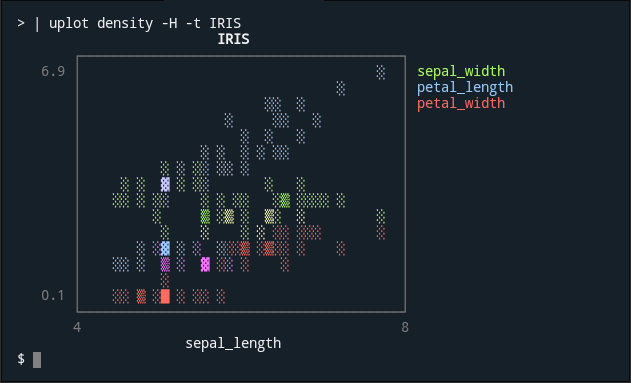mirror of
https://github.com/red-data-tools/YouPlot.git
synced 2025-05-06 07:10:10 +08:00
148 lines
3.8 KiB
Markdown
148 lines
3.8 KiB
Markdown

|
|
|
|

|
|
[](https://badge.fury.io/rb/youplot)
|
|
[](https://rubydoc.info/gems/youplot)
|
|
[](LICENSE.txt)
|
|
[](https://zenodo.org/badge/latestdoi/283230219)
|
|
|
|
YouPlot - Create ASCII charts on the terminal with data from standard streams in the pipeline.
|
|
|
|
:bar_chart: Powered by [UnicodePlot](https://github.com/red-data-tools/unicode_plot.rb)
|
|
|
|
## Installation
|
|
|
|
```
|
|
gem install youplot
|
|
```
|
|
|
|
## Quick Start
|
|
|
|
### barplot
|
|
|
|
```sh
|
|
curl -sL https://git.io/ISLANDScsv \
|
|
| sort -nk2 -t, \
|
|
| tail \
|
|
| uplot bar -d, -t "Areas of the World's Major Landmasses"
|
|
```
|
|
|
|

|
|
|
|
### histogram
|
|
|
|
```sh
|
|
echo -e "from numpy import random;" \
|
|
"n = random.randn(10000);" \
|
|
"print('\\\n'.join(str(i) for i in n))" \
|
|
| python \
|
|
| uplot hist --nbins 20
|
|
```
|
|

|
|
|
|
### lineplot
|
|
|
|
```sh
|
|
curl -sL https://git.io/AirPassengers \
|
|
| cut -f2,3 -d, \
|
|
| uplot line -d, -w 50 -h 15 -t AirPassengers --xlim 1950,1960 --ylim 0,600
|
|
```
|
|
|
|

|
|
|
|
### scatter
|
|
|
|
```sh
|
|
curl -sL https://git.io/IRIStsv \
|
|
| cut -f1-4 \
|
|
| uplot scatter -H -t IRIS
|
|
```
|
|
|
|

|
|
|
|
### density
|
|
|
|
```sh
|
|
curl -sL https://git.io/IRIStsv \
|
|
| cut -f1-4 \
|
|
| uplot density -H -t IRIS
|
|
```
|
|
|
|

|
|
|
|
### boxplot
|
|
|
|
```sh
|
|
curl -sL https://git.io/IRIStsv \
|
|
| cut -f1-4 \
|
|
| uplot boxplot -H -t IRIS
|
|
```
|
|
|
|

|
|
|
|
### count
|
|
|
|
In this example, YouPlot counts the number of chromosomes where the gene is located from the human gene annotation file and create a bar chart. The human gene annotation file can be downloaded from the following website.
|
|
|
|
* https://www.gencodegenes.org/human/
|
|
|
|
```sh
|
|
cat gencode.v35.annotation.gff3 \
|
|
| grep -v '#' | grep 'gene' | cut -f1 | \
|
|
uplot count -t "The number of human gene annotations per chromosome" -c blue
|
|
```
|
|
|
|

|
|
|
|
Note: `count` is not very fast because it runs in a Ruby script.
|
|
This is fine if the data is small, that is, in most cases. However, if you want to visualize huge data, it is faster to use a combination of common Unix commands as shown below.
|
|
|
|
```sh
|
|
cat gencode.v35.annotation.gff3 | grep -v '#' | grep 'gene' | cut -f1 \
|
|
|sort | uniq -c | sort -nrk2 | awk '{print $2,$1}' \
|
|
| uplot bar -d ' ' -t "The number of human gene annotations per chromosome" -c blue
|
|
```
|
|
|
|
## Usage
|
|
|
|
### file
|
|
|
|
### stream
|
|
|
|
### help
|
|
|
|
Use `--help` to print command-specific options.
|
|
|
|
`uplot hist --help`
|
|
|
|
```
|
|
Usage: uplot histogram [options] <in.tsv>
|
|
|
|
Options for histogram:
|
|
--symbol VAL character to be used to plot the bars
|
|
--closed VAL
|
|
-n, --nbins VAL approximate number of bins
|
|
|
|
Options:
|
|
...
|
|
```
|
|
|
|
### colors
|
|
|
|
```sh
|
|
uplot colors
|
|
```
|
|
|
|
|
|
## Development
|
|
|
|
Let's keep it simple.
|
|
|
|
## Contributing
|
|
|
|
Bug reports and pull requests are welcome on GitHub at [https://github.com/kojix2/youplot](https://github.com/kojix2/youplot).
|
|
|
|
## License
|
|
|
|
[MIT License](https://opensource.org/licenses/MIT).
|